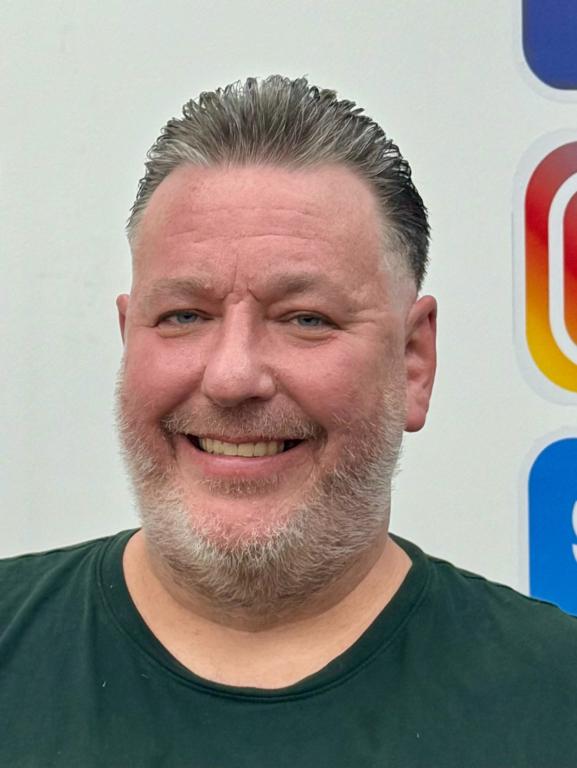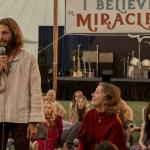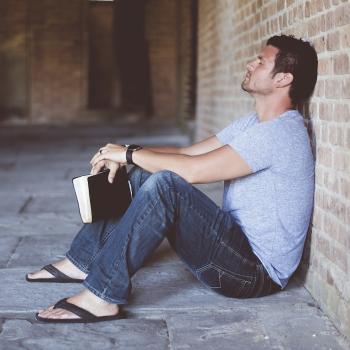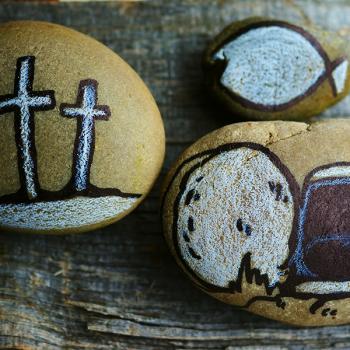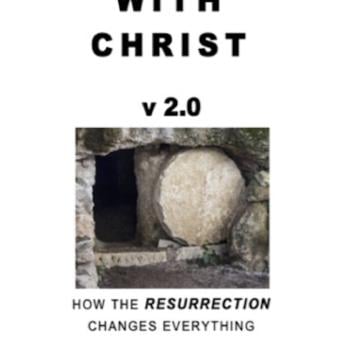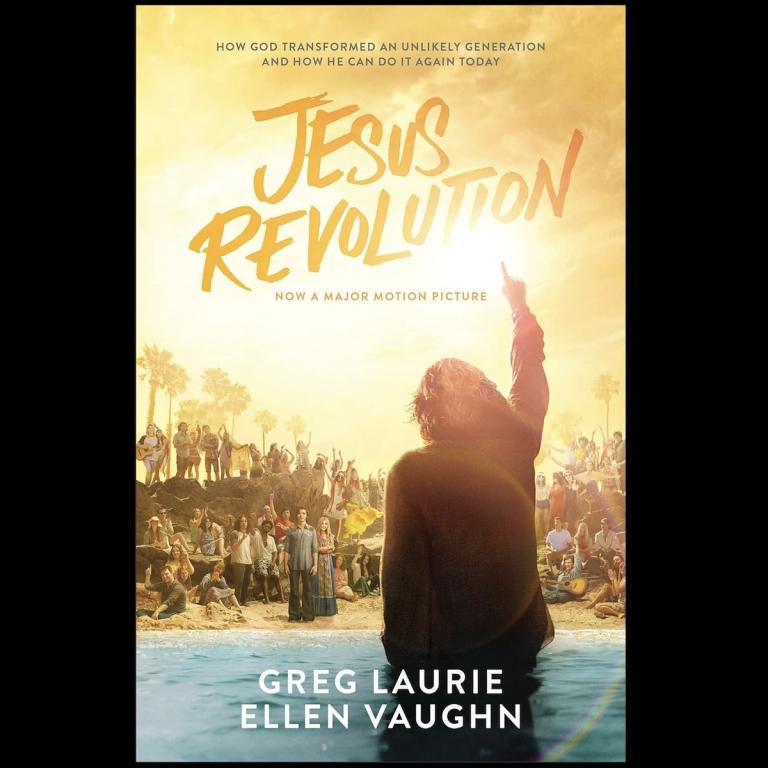
Greg Laurie is the young hippie convert featured in The Jesus Revolution movie. The film is based on his book, which is why the movie is told through his eyes. The revival which sprung from these events is the largest ever known in the West.
We see in Greg Laurie and the massive influence he has had on Christianity that the impact of the Jesus Revolution continues till today. As we shall see, what Greg has seen God do through his ministry is just one aspect of the huge ripple like effects of this amazing move of God.
Laurie’s book is available on Amazon UK and US and many other outlets. Here is how it is described by the publisher:
It’s 1970 . . . There is the beach, dotted with fire pits. There is an outcropping of cliffs that form a natural amphitheater near the mouth of the harbor. The rocks look wrinkled at this height. The sun is setting.
As you get closer, you see that there is a huge crowd massing the area. At first the people look like ants. They’re perched on the rocks, sitting on the sand, standing in the shallows of the rolling water. They have their arms around each other. They seem to be singing. . .
There is a long-haired teenaged boy. He looks like he’s about seventeen. He’s more quiet and reserved than the girls, as if he still carries the burdens of the past dead ends of drinking, drug use, and skeptical despair. A bearded pastor in a flowing tunic, sopping wet, dunks the young man down in the cold water for a long moment. It’s as if he’s been buried.
Then the hippie pastor raises the kid up, and the teenager bursts out of the sea, water streaming from his face and hair and shoulders.His heart is on his face,and he is weeping. Joy. Release. Freedom. The first thing he gasps, though, is strange:
“I’m alive!”
“There can’t be any large-scale revolution until there’s a personal revolution, on an individual level. It’s got to happen inside first.” Jim Morrison
“A true revival means nothing less than a revolution, casting out the spirit of worldliness and selfishness, and making God and His love triumph in the heart and life.” Andrew Murray
The hippies who plunged into the Pacific Ocean during that summer sunset in 1970 didn’t know they were in a revival. They didn’t even know what a revival was. They were not acquainted with Christian vocabulary words like revival orsalvation or sanctification.
But thanks to the Beatles, Jim Morrison, and other countercultural icons of the day, the hippies did know about words like revolution.
They were part of a youth culture that revolted against what they called “the Establishment,” the mainstream’s reigning values of conformity and the rat race of material success and achievement. They were more interested in achieving higher levels of consciousness through drugs, grooving on the music of the day, and enjoying sexual adventures free from the convention of marriage. They were for the planet, flowers, and everybody just getting along.
This youth revolution was in full swing when a deeper, stronger, and more radical tide began to surge.
It was called the Jesus Revolution, or the Jesus Movement. It swelled among young people—the baby boomer generation—in the US from the late 1960s into the early 1970s. It was the largest public movement of the Holy Spirit in the United States since the celebrated revivals of the nineteenth century. National magazines wrote colorful feature stories about this mass spiritual phenomenon, as did newspapers like the New York Times.
More people were baptized during the Jesus Revolution than in any time since people started keeping records. They were flower children, hippies, yippies, druggies, and square church kids. Teenagers who had run away from home got saved on the streets. Junkies got clean. Churches—the ones that would accept barefoot flower children sitting on their carpets and curling their bare toes in the communion cup racks—overflowed with new believers . . .
The churches that welcomed the hippies grew in grace and vigor; the ones that didn’t missed both the boat and the blessing . . . Some religious leaders, like Billy Graham and Campus Crusade founder Bill Bright, embraced the Jesus Movement. Their Explo ’72 drew eighty thousand kids to the Cotton Bowl in Texas for a five-day festival of Bible study, worship, telling others about their faith, and serving needy people in the surrounding areas.
The Jesus Revolution brought new forms of worship into mainstream experience. Before it, young people in churches had two musical options: old hymns or cheery camp songs. Then, as hippie musicians who came to Jesus applied their talents to writing praise music about Him, Christian teenagers had new music to call their own. The resulting creative explosion—what’s known now as contemporary Christian music—changed the face of worship in many churches for decades to come.
Many who came to faith in Christ in those heady days went on to become missionaries, pastors, and lay leaders. They had families. They started all kinds of new churches and parachurch and social justice ministries. Many of the ’70s converts who became pastors started churches that grew . . . and grew. Since they’d once been outsiders, the Jesus People generation wanted to make sure their churches weren’t just bastions of comfy Christians speaking a language only the faithful could understand. They welcomed outsiders, whom they called “seekers,” and within a decade or two, mega- churches started popping up, like very large mushrooms, across the United States . . .
Our story here is more than just a vintage tale of what God did in a past generation. It’s a bit of time travel, or a message in a bottle from an intriguing, long-gone era. And the message is this: God can do it again. He can surprise us all with a new season of extraordinary, radical, spine-tingling hope, and a new flood of His Holy Spirit on a new generation.
A new Jesus Movement would not look the same as it did fifty years ago. But in our own unruly times, God can cer- tainly bring powerful revival to His church and an awakening among people who don’t yet know Him.
But that is something He tends to do only if people admit they need Him.
The hippies, flower children, and others who came to Jesus back in the ’60s were desperate. They were willing to go to any lengths, or on any trip, to find what they were look- ing for.” READ MORE
In my Logos Bible Software library is an earlier book by Greg Laurie in which he tells his story briefly. He describes the church that he planted in the film like this in 1999:
If you came to a service at Harvest Christian Fellowship, it would probably seem very contemporary to you. We have a relatively simple building, with no religious symbols to speak of. The music is clearly contemporary, and the dress style is casual. But underneath all of that are timeless biblical principles. This ministry could be compared to a Windows 98 operating system. On the surface it is brightly colored, with simple icons to click. But underneath it is a DOS infrastructure. A healthy and thriving church must have a strong infrastructure. If you don’t have a good foundation, trouble is coming, regardless of your growth, be it numerical or financial.
Laurie, G. and Kopp, D. (1999) The Upside Down Church. Wheaton, IL: Tyndale House Publishers, Inc., pp. 2–3.
We see a little of how Greg went from new convert to pastor in the movie but this is how he describes his first sermon in his 1999 book:
The day I first preached publicly did come . . . it happened as the result of a misunderstanding. The church I attended was holding a mass baptism down at a beach in Newport Beach, California. I thought it was later that day, but it had already taken place, and I had missed it. When I rolled out of bed that morning, it was a day like any other day—no visions, no audible voices from heaven, no signs or wonders. But that day was about to alter the course of my life. I arrived at the beach, and instead of finding a few thousand people, as would be gathered for a baptism, I found only a handful. I was disappointed to have missed the baptism but glad to find some fellow believers to sing and fellowship with. As I joined their group I quickly noticed that no one was really leading. One person would sing a song, and others would join. Then another would sing a song, and we would sing again. I had read a passage of Scripture that morning that was sort of burning inside, and I sensed God nudging me to share it with this little group.
“Excuse me, but I read a Scripture this morning that I would like to share!” I blurted out nervously. Everyone seemed agreeable to the idea, so I stammered away, and when I was done, I was so relieved. I was saying to the Lord, quietly in my heart, Lord, thank you for that wonderful opportunity! I can’t wait to tell some of my Christian friends how you used me.
I thought I was done that day, but the Lord was just getting started. While I was speaking, a couple of girls had joined our little group. When I finished, one of them said to me, “Excuse me, Pastor, but we missed the baptism, and we were wondering if you could still baptize us?”
“Pastor”?—what, is this girl nuts? I thought. “I’m sorry, I am not a pastor, and I don’t even know how to baptize someone!” I protested.
“But we want to be baptized. Can’t you help us?”
And then the Lord gave me a great sense of peace and impressed it upon my heart to go ahead and do it. “Uh, OK, I guess I could do that. Umm, let’s go on down to Pirate’s Cove.”
Pirate’s Cove is a charming little natural amphitheater, a spot etched in rock overlooking a small beach. Many times during the year, Calvary Chapel would have hundreds sit up on the rocks and watch as Pastor Chuck Smith and others baptized people. I had been baptized there myself, so it held fond memories for me. Except this time I was leading a little group that had now grown to about thirty down to Pirate’s Cove, and I had no idea what I was going to do once I got there. As we went to the water’s edge, I racked my brain, trying to remember something I had never really paid much attention to. The actual technique of baptizing a person! I remembered watching Pastor Chuck Smith holding a person’s nose as he supported his back and gently lowered them backwards into the water. So I did the same and awkwardly baptized the first girl. She was still breathing afterwards, and I was greatly relieved. Then I baptized the second and was starting to feel like an old pro! As I came out of the water once again, I quietly rejoiced in this wonderful opportunity God had opened up for me.
While I was preparing to leave, I noticed that a crowd had gathered up on the rocks, taking all of this in. Then the thing I feared most came upon me. God clearly spoke to my heart and said one thing: “Preach!” Instead of being terrified, I had a great sense of calm and to the best of my ability proclaimed the gospel in my first little crusade. I even invited people to come down to where we were and receive Christ. A few did, and I had the privilege of baptizing them that day, too. Now I was ruined. I had the bug. Deep down, I knew that I was called to do this.Laurie, G. and Kopp, D. (1999) The Upside Down Church. Wheaton, IL: Tyndale House Publishers, Inc., pp. 3–5.
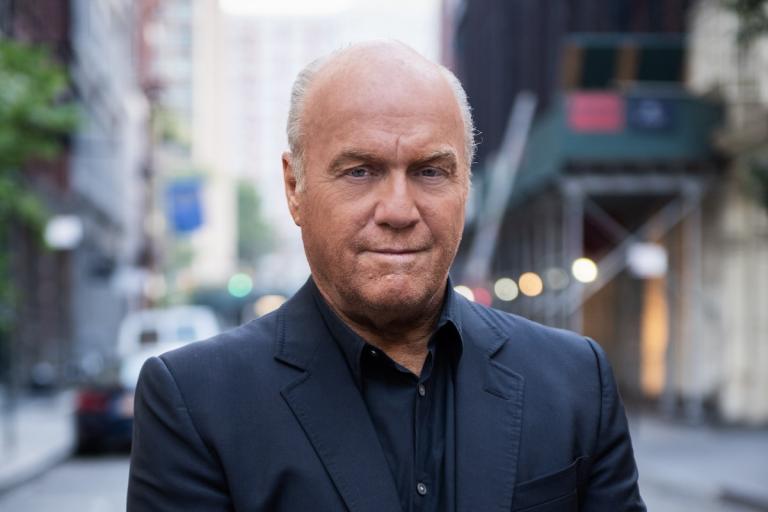
But how did that initial sermon lead to him becoming a pastor? Again this was a spontaneous God-lead thing but he was supported strongly by Chuck Smith as the movie portrayed:
“An Episcopal church in a city called Riverside wanted to see if what God was doing in the Jesus movement down in Orange County could happen in their city as well. Some of the leaders of that church approached Chuck Smith and asked if he would send up some of the associate pastors to teach a Bible study aimed at young people. They rotated, each doing it for a few weeks and then handing it off to another. One particular week no one really wanted to go. They were talking about it among themselves as I quietly listened. One of the pastors said, “Hey, why not have Greg go up there?” They all agreed and said I could take the next Sunday night. I studied hard that week and desperately wanted to do well.
When I showed up at the church, I quickly realized no one had told them I was coming. They were expecting a pastor they already knew. The elder in charge reluctantly agreed to have me preach and said that he would be watching and listening very closely that night. Not exactly a vote of confidence! But I made my way through it and was told I could come back again the next week. So each week I spoke, and attendance actually began to grow. People started to receive Christ, and I was beside myself with joy! In fact, it grew into a group of about three hundred, and some of the people were starting to call me Pastor Greg. Here was the “pastor” thing again. It was almost laughable. I was twenty years old! I had been a Christian for only three years. I hardly felt qualified to be a pastor. Besides, I really felt called to evangelism, not pastoring. But this crazy Bible study just kept growing.
This little Bible study that I had the privilege of leading had now, for all practical purposes, become a church. We had outgrown the facilities at the Episcopal church where we began, so we looked for our own building. I was told of a Baptist church in the middle of town that had had a split and was available for lease or rent. We had no money in the bank and were really a bunch of kids just trying to do what we thought God wanted us to do. I called Chuck Smith and asked him if he would come and check this thing out with me. As we walked around the building, taking it all in, Chuck spoke with the Realtor who had listed it. I saw Chuck take out his checkbook, write out a check, and hand it to the Realtor. They shook hands, and Chuck came over to me and said, “Well, congratulations, Greg. You just got yourself a church!” He had to get back to Costa Mesa, so he climbed into his car and drove out of the parking lot, and I just stood there stunned.
What was I going to do? Who was going to help me? Was I really called to do this? As it turned out, Pastor Chuck had provided the down payment, but the rest was up to us. The next Sunday we made the announcement at the Episcopal church that we were moving to this new building. I was terrified that no one would follow us. But the next week they showed up in force. We were now five hundred strong!
I felt called primarily as an evangelist. Prior to taking on this Bible study, in addition to doing graphics I had become something of an itinerant preacher. I traveled with a number of the early contemporary Christian music groups, and I sort of emceed the evening and then got up and preached the gospel and gave an invitation for people to come to Christ. As itinerant, or traveling, preachers often do, I had developed five or six messages that I gave over and over, and they were well honed.
Yet now, here I was, called upon to teach every single week in the same place in this new and growing church that I had somehow become the pastor of. We had not only our Sunday night services but Wednesday services as well. I had to learn how to really study. I decided to teach through the books of the Bible as I had seen modeled at Calvary Chapel. I decided to start with Ephesians . . . on Sunday nights, instead of topical evangelistic messages, I taught through books like the Gospel of John, Revelation, Genesis, Daniel, etc. Then I still gave an invitation for people to come to Christ. Now they were responding. And we began to grow even more.”
Laurie, G. and Kopp, D. (1999) The Upside Down Church. Wheaton, IL: Tyndale House Publishers, Inc., pp. 6–9.
Greg Laurie also went on to lead huge Harvest Crusades, these once again had a spontaneous God-ordained beginning:
“Like so many other things in my life, the opportunity to do crusades came when I least expected it. Chuck Smith asked if I would speak at a Monday night Bible study at Calvary Chapel, a study he had led for many years. I had attended it myself. It was a great honor to be asked to do this, and though our church was going strong and there were many things pulling on me, I sensed the Lord’s leading to go for it. I applied the same format we have used for years at Harvest on Sunday nights: a time of contemporary praise and worship; often a guest musical artist (not usually announced ahead of time); and then a forty-five- to sixty-minute Bible study with evangelism woven through it.
Before we knew it, we were averaging twenty-five hundred people each Monday night, with anywhere from forty to eighty people coming to Christ each week. We were thrilled with the response. . . After this had gone on for about a year, I was at a meeting with some other pastors down in Costa Mesa, and Chuck Smith took me aside for a moment and dropped something on me that would change the course of my life and ministry. In his matter-of-fact way he said, “Greg, I’ve been noticing the Lord’s blessing on the Monday-night studies this last year and thought we should take it to a larger venue, say, the Pacific Amphitheater, and do a Billy Graham-style crusade.”
I was dumbfounded. “Isn’t the Pacific Amphitheater a pretty big place, Chuck?” I asked.
“Yes, Greg, it is,” Chuck said, with a twinkle in his eye. Then he added, “But we serve a big God!”
We had no idea how many people to expect for that first crusade. I wanted to take what God had been blessing in our Sunday-/Monday-night studies and combine it with some tried-and-true principles of large-scale evangelism. I had long studied the ministries of evangelists like D. L. Moody and Billy Graham. I wanted this crusade to build on the principles of what God had blessed over the years, combined with contemporary style and music. So we went about designing a new approach to the crusade format. My associate, John Collins, helped to brilliantly execute this first event and continues as our crusade director to this very day. The Lord has been faithful these last ten years, and we have seen over 2 million people in combined attendance, and over 150,000 people have walked the aisles to make commitments and recommitments to follow Jesus Christ.”
Laurie, G. and Kopp, D. (1999) The Upside Down Church. Wheaton, IL: Tyndale House Publishers, Inc., pp. 11–13.
We see in Greg Laurie and the massive influence he has had on Christianity in the West that the impact of the Jesus Revolution continues till today. As we shall see, what Greg has seen God do through his ministry is just one aspect of the huge ripple like effects of this amazing move of God.
READ MORE
The Jesus Revolution: A Review of the Hippies for Jesus Film


